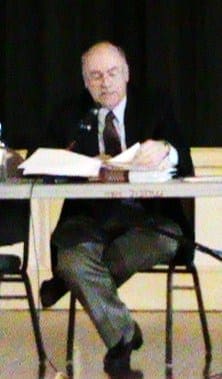A near capacity audience gathered for two hours on Tuesday, March 27, at the Saratoga Springs City Hall’s Music Hall at the invitation of Commissioner of Public Safety, Christian Mathiesen for a workshop entitled “Night Life in Saratoga Springs: Is it a Problem?”
Though many issues were discussed, the one that proved to be of greatest interest was a proposal to change the city’s last call from 4 a.m. to3 a.m., a proposal Mathiesen has said has his support. Neighbors to the downtown area, business owners and concerned citizens approached the microphone to voice their thoughts on the matter and some issues connected to it, likenoise.
There was a similar meeting on March 7, coordinated by Lt. John Catone of the Saratoga Springs Police Department, that included bar and restaurant owners, the state department of licensing, and the Prevention Council, among others. Issues of whether or not to have bouncers certified and responsibilities of businesses that serve alcohol were brought to the table.
“We needed to address downtown. … We put together a group of people that hadn’t been done before. We all got a lot of good things out of it. We didn’t address last call, that wasn’t the purpose of the meeting,” said Catone.
Before the public spoke at Tuesday’s meeting, Mathiesen took afew minutes to share some of his own observations. Last June, he set his alarmclock for 3:10 a.m. and drove downtown to check things out for himself.
He read from his first entry into what became a diary of sorts,saying, “I can hear the crowd many blocks before I arrive at Caroline Street…there are many Saratoga Springs police, with one mounted on a horse. Also, there arethree sheriff’s deputy cars, one of which arrives with sirens blaring and oneState Police car. It’s a very large crowd of people, many intoxicated andfilling the entire two blocks of Caroline Street.”
Other entries from over the summer are similar, he said, and gave his accounts of witnessing altercations between patrons and police, one ofwhich involved a riot at Club Shadow on June 26. Mathiesen noted to the audiencethat of the many altercations he witnessed, none were reported in newspapers,except the Club Shadow riot. Club Shadow was closed soon thereafter.
Besides the time of last call, issues like manpower in the form of police patrol, noise generated by music, lack of cabs and revenue made inthose last couple of hours before many bars close were brought up. The image ofthe city portrayed to tourists and convention goers was discussed as well.
“It’s turned into a dangerous situation…and it needs to be addressed,” said Mathiesen who called attention to the fact that although manypolice are present during summer months, they are not able to make a lot of arrests because they’re busy keeping the crowds under control.
Assistant City Attorney Tony Izzo spoke briefly about changeable regulations, ordinances and updates to insurance requirements regardingbusinesses and noise in the downtown area. There has been a noise ordinance ineffect in the city since 1937.
“One of the things currently most ripe for discussion is sidewalk cafes. … Since 1975, if there have been two violations for a sidewalk cafe (cabaret) only, that operator will automatically revoke the license for thatsidewalk cafe for a period of one year. It is proposed at this point that it been expanded to include hotels, eating and drinking establishments. It’s on thetable,” said Izzo.
A majority of the audience was made up of restaurant and bar owners who took the opportunity to voice their concerns.
John Baker, owner of Gaffney’s said that imposing an earlier closing time would likely contribute to a 15 to 20 percent reduction in workforce and “hundreds of jobs being lost” among establishments that cater to thenightlife.
“At this time, according to the National Restaurant Association, restaurants had 250,000 jobs in 2011 and expect that trend to continue in 2012.Many establishments do 20 percent of their business between the 2 and 4 (a.m.)time period,” said Baker.
He added that a drop in business would also lead to a drop insales tax revenue.
Linda Crawford, a resident, said the city’s nightlife is hurting its image.
“I look at it to where you’re the enforcers. I love therestaurants and the bars but if you’ve got downtown, which you have … you knowwhat happens. Girls fall down on their knees on Caroline Street at 11:30 or 12 because they’re so plastered. The businesses would not lose any money if you closed at 2. If you had a 2 o’clock last call and stayed open until 3, how areyou going to lose money? They’re just going to drink faster.”
Patrick Klimaszewski, a senior at Skidmore College andanthropology major, has chosen to examine Saratoga Springs bars for a researchpaper.
“Saratoga sells itself as a place with health, horses andhistory – yet we are also a place that offers more chances to get drunk than anywhere else in the county. We started off as a place associated with mineralwater. … I think Saratoga is confused as to what it’s selling itself as. As afamily town but also as a place for entertainment,” said Klimaszewski.
No decisions were made at the workshop, but Mathiesen hopes tobring issues discussed at Tuesday’s meeting to the City Council next month.



